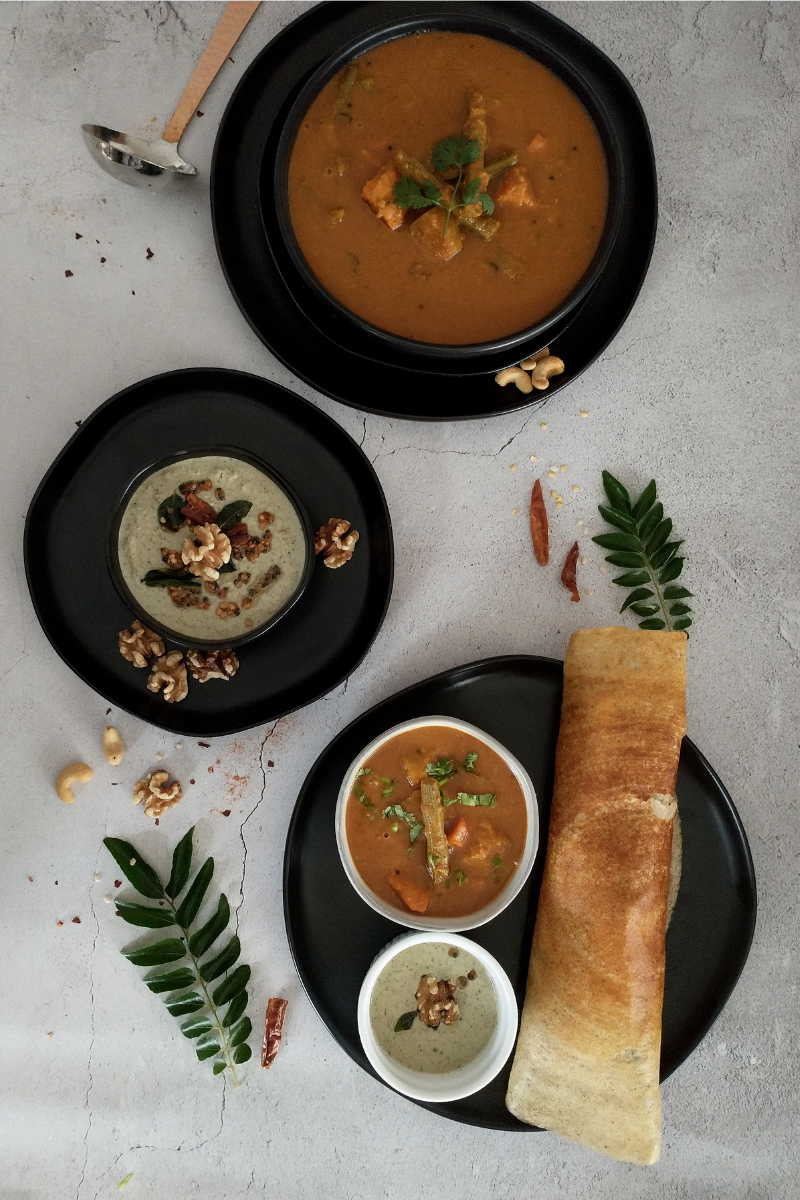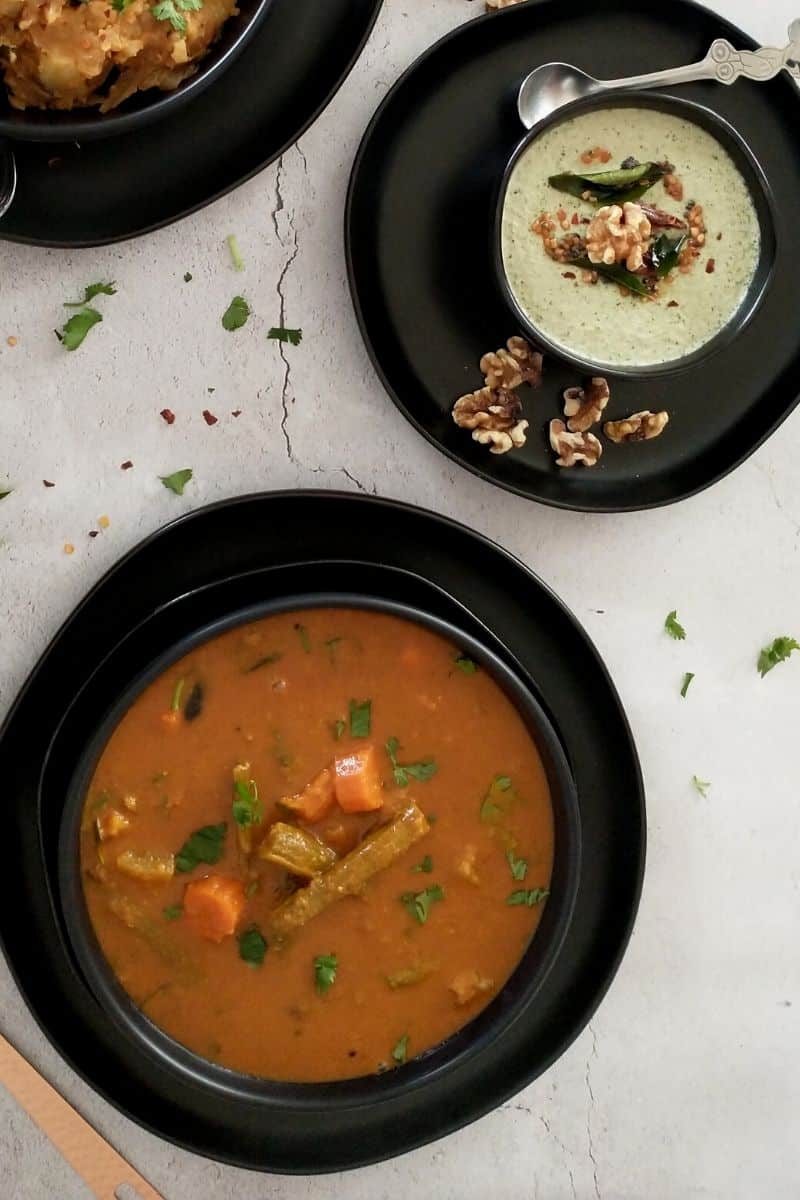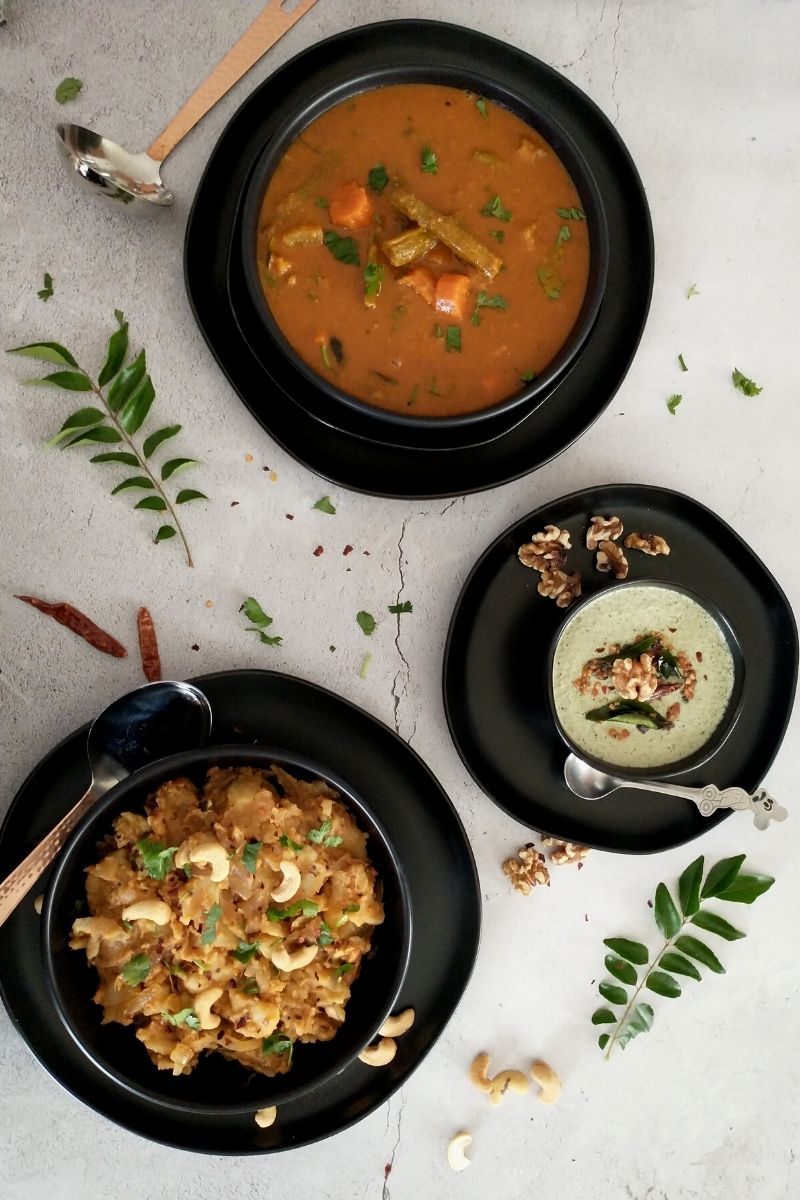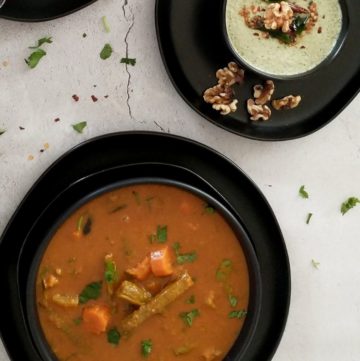Udupi Sambar is a popular dish from South India, made with split pigeon peas, vegetables and freshly made sambar masala which adds a ton of flavor to this dish.
This sambar is a balance of sweet and tangy flavors with a little touch of spiciness. Serve it with dosa, idli, or steamed white rice.

Jump to:
Udupi Sambar - Recipe Video
About Udupi Sambar
Fresh vegetables are cooked in sweet and tangy lentils and freshly made sambar masala add soul to this Udupi sambar. Udupi sambar is famous from Temple town called Udupi in southern Indian state of Karnataka.
I have tried Udupi sambar at different restaurants nearby. Some are mild, wherese some are spicy. Some include onions and some don't. I have not included onions in my recipe. If you prefer you can add some sliced, or small pearl (sambar) onions to sambar.
I like the combination of bottle gourd, eggplant, vegetable drumsticks (fruit of moringa plant), pumpkin, and carrots in my sambar. I think these veggies compliment each other. Add your choice of gourds or pumpkins. Potatoes, green beans, peas, sweet potatoes make a great addition to sambar.
The key to this flavorsome Udupi sambar is its freshly ground sambar masala. Dry roasted spices and freshly grated coconut, pound into a smooth sambar paste.
Vegetables are simmered in lentils and freshly ground sambar masala for the aromatic, lip-smacking Udupi sambar. That slight tang from the tamarind and sweetness from the jaggery, brings out the best in the sambar.
Enjoy this lightly spiced, sweet and tangy, aromatic Udupi sambar with some dosa or idlis. It goes well with steamed rice. We enjoyed this sambar with some Nav Dhan Masala Dosa (no rice dosa).
Ingredients For Udupi Sambar
Don't get intimidated with the ingredients list. Trust me making this sambar recipe is a breeze. Most of the ingredients used in recipe are what you might already have in your pantry.
Ingredients For Udupi Sambar Masala
- 2 teaspoon coriander seeds
- 1 teaspoon cumin seeds
- ¼ teaspoon methi dana (fenugreek seeds)
- 2 teaspoon urad dal (husked and split black gram)
- 1 teaspoon chana dal (husked and split bengal gram)
- 7-8 whole byadagi or kashmiri red chili
- ¼ cup fresh or frozen coconut, grated
- 1-2 sprigs curry leaves
- ⅛ teaspoon hing (asafoetida)
- ½ -¾ cup water, as required to grind into a smooth paste
Ingredients For Sambar
For pressure cooking:
- ½ cup toor dal
- ¼ teaspoon turmeric powder
- 2 cups water
- salt to taste
For pot-in-pot veggies:
- 2 cups mix veggies (bottle gourd, eggplant, pumpkin, carrots, vegetable drumsticks)
- ¼ cup water
- pinch of turmeric powder
- salt to taste
To Be Added After Pressure Cooking:
- 1 tablespoon tamarind pulp, adjust to taste
- 1-2 teaspoon jaggery, adjust to taste
For The Tempering:
- 1 teaspoon mustard seeds
- 2-3 dry dried red chili
- pinch of hing (asafoetida)
- 1-2 sprigs curry leaves
- 1 tablespoon coconut oil or vegetable oil
For The Garnish:
handful of fresh cilantro, chopped
Pic Shown: Top to bottom - Udupi Sambar, Walnut Coconut Chutney, Nav Dhan Masala Dosa[no rice dosa]

How To Make Udupi Sambar
I have divided this recipe into three main components.
- First, pressure cook lentils and veggies. I use pot-in-pot method to cook the dal and veggies in my pressure cooker.
- Second, make the Udupi sambar masala.
- Third, simmer the lentils, and veggies in an aromatic Udupi sambar masala. It's that easy!
Step 1: Pressure Cook The Dal
- Rinse the toor dal few times. Soak the dal in water for 30 minutes.
- After 30 minutes, drain the dal and add it to the inner pot of Instant Pot. Add water, turmeric powder, salt to taste.
- Add all the vegetables to the insert, add some water, turmeric powder, salt to taste.
- Place a trivet in the inner pot. Place the insert with vegetables on the trivet.
- Close Instant Pot, vent on sealing position. Select Pressure cook for 10 minutes.
- After the Instant Pot beeps, let the pressure release naturally.
- Open the Instant Pot, carefully remove the insert using the tongs.
- Mash the dal with the ladle.

Step 2: Prepare The Udupi Sambar Masala
- Dry roast all the ingredients (except grated coconut, hing, curry leaves) listed under the Udupi Sambar Masala.
- Turn OFF heat.
- Add grated coconut, hing, curry leaves and sauté 1-2 minutes in the residual heat.
- Transfer the roasted ingredients onto a clean plate, cool completely.
- Add the ingredients to a blender jar and blend it into a smooth paste. Add water as needed to grind the masala. Set the masala aside.

Step 3: Add The Udupi Sambar Masala
- Turn on the sauté (low), and add prepared Udupi sambar masala. Bring the mixture to a boil. Stir in-between to avoid masala sticking to the inner pot.
- Add tamarind pulp, jaggery and vegetables to the inner pot. Mix well.
- Simmer the sambar for 2-3 minutes. Adjust the seasoning. Turn OFF sauté.
- Prepare the tempering. Heat oil in a pan. Add mustard seeds. Let the seeds splutter.
- Reduce the heat to low, add asafetida, whole dry red chili, curry leaves.
- Add the tempering over the sambar. Mix well. Garnish with fresh cilantro.
- Enjoy Udupi Sambar with some dosa, idli, or steamed white rice!
Pic Shown: Top to bottom - Udupi Sambar, Walnut Coconut Chutney

Tips For Delicious Udupi Sambar
Key to good food is fresh ingredients. Use fresh ingredients if possible.
Don't skip the final tempering. It adds a nice aromatic flavor to the sambar.
Udupi sambar is lightly spiced, sweet and tangy. Adjust the spiciness as per taste. Green chili or red chili powder can be used to add spiciness to it.
You can adjust the sour or tanginess in the sambar by adding a little jaggery or brown sugar to balance the flavors.
Slow roasting enhances the flavor of the spices. Dry roast the spices on low to medium heat. Immediately transfer the spices to a clean, dry plate to cool completely. Roast the coconut using the residual heat in the pan.
I used Byadagi dried red chili to make the Udupi sambar. It is mildly flavored and is mainly used for it's color. You can use dried Kashmiri red chili for this recipe.
Fresh or frozen grated coconut can be used in this recipe.
Fresh curry leaves add a nice flavor to the sambar. Dry curry leaves will work fine too. Can’t find curry leaves where you live? Simply skip the curry leaves.
A combination of vegetables add a nice flavor to the sambar. The taste of the sambar will depend on the vegetables used. We love the combination of lauki, eggplant, vegetable drumsticks, carrots, and pumpkin. You can add veggies of your choice.
Chop the veggies into slightly bigger chunks. It will prevent them from getting mushy in the pressure cooker.
We like medium consistency sambar. Adjust the consistency of the sambar by adding less or more water to suit your taste. If adding more water, adjust the seasoning as well.
Sambar thickens over a period of time, feel free to add water to adjust the consistency as per your liking.
Sambar tastes better after a couple of hours. It allows all the flavors to blend in well.

Frequently Asked Questions
Can you use other lentils?
Typically, Udupi sambar is made using toor dal(split pigeon peas). Split petite yellow lentils (moong dal), or red lentils (masoor dal) can be used in sambar. A combination of lentils works fine as well.
Note: Depending upon the type of lentils used, the taste and texture of sambar will vary.
What veggies to add?
I like the combination of bottle gourd, eggplant, vegetable drumsticks (fruit of moringa plant), pumpkin, and carrots in sambar. I think these veggies compliment each other. Add your choice of gourds or pumpkins. Potatoes, green beans, peas, sweet potatoes make a great addition to sambar.
Can I skip jaggery?
Jaggery adds a hint of sweetness to the sambar. Jaggery is added in a very small quantity, just to balance all the flavors. You can add sweetener of choice or skip it, works just fine.
Substitute for tamarind
You can use some lemon or lime juice, to add the tanginess to the sambar. Green mango (unripe mango) may be used for tangy flavor.
Why is dal not cooked?
The suggested time in the recipe has worked for me most of the time. If for any reason the dal is not cooked properly, remove the veggies and pressure cook the dal again for 5-10 minutes.
Serving Suggestions
We love Udupi sambar with dosa, idli, or mendu Vada. Serve it with Walnut Coconut chutney and enjoy!
Storage
Udupi sambar stays fresh for 4-5 days in the refrigerator. Store it in a air-tight, glass container. Avoid storing the sambar in a metal container.
Udupi sambar can be frozen for up to a month. Freeze it in a freezer safe container. Defrost it in the refrigerator, heat and serve.
Pic Shown: Top to bottom - Udupi Sambar, Walnut Coconut Chutney, Red Chutney Aloo Masala [Spicy Potato Stuffing]

More South Indian Recipes
Quinoa Mysore Masala Dosa (no rice dosa)
Mysore Masala Dosa Red Chutney
Classic Aloo Masala (Potato Stuffing)
Mixed Lentils Dosa (no rice dosa)

Udupi Sambar
Equipment
Ingredients
Ingredients For Udupi Sambar Masala
- 2 teaspoon coriander seeds
- 1 teaspoon cumin seeds
- ¼ teaspoon methi dana (fenugreek seeds)
- 2 teaspoon urad dal (husked and split black gram)
- 1 teaspoon chana dal (husked and split bengal gram)
- 7-8 byadagi or kashmiri red chili
- ¼ cup fresh or frozen coconut, grated
- 1-2 sprigs curry leaves
- ⅛ teaspoon hing (asafoetida)
- ½ -¾ cup water, as required to grind into a smooth paste
Ingredients For Sambar
For pressure cooking:
- ½ cup toor dal
- ¼ teaspoon turmeric powder
- 2 cups water
- salt to taste
For pot-in-pot veggies
- 2 cups mix veggies (bottle gourd, eggplant, pumpkin, carrots, vegetable drumsticks)
- ¼ cup water
- pinch of turmeric powder
- salt to taste
To Be Added After Pressure Cooking:
- 1 tablespoon tamarind pulp, adjust to taste
- 1-2 teaspoon jaggery, adjust to taste
For The Tempering:
- 1 teaspoon mustard seeds
- 2-3 dried red chili
- pinch of hing (asafoetida)
- 1-2 sprigs curry leaves
- 1 tablespoon coconut oil or vegetable oil
For The Garnish:
- handful of fresh cilantro chopped
Instructions
How To Make Udupi Sambar
- I have divided this recipe into three main components.
- First, pressure cook lentils and veggies. I use pot-in-pot method to cook the dal and veggies in my pressure cooker.
- Second, make the Udupi sambar masala.
- Third, simmer the lentils, and veggies in an aromatic Udupi sambar masala. It's that easy!
Step 1: Pressure Cook The Dal
- Rinse the toor dal few times. Soak the dal in water for 30 minutes.
- After 30 minutes, drain the dal and add it to the inner pot of Instant Pot. Add water, turmeric powder, salt to taste.
- Add all the vegetables to the insert, add some water, turmeric powder, salt to taste.
- Place a trivet in the inner pot. Place the insert with vegetables on the trivet.
- Close Instant Pot, vent on sealing position. Select Pressure cook for 10 minutes.
- After the Instant Pot beeps, let the pressure release naturally.
- Open the Instant Pot, carefully remove the insert using the tongs.
- Mash the dal with the ladle.
Step 2: Prepare The Udupi Sambar Masala
- Dry roast all the ingredients (except grated coconut, hing, curry leaves) listed under the Udupi Sambar Masala.
- Turn OFF heat.
- Add grated coconut, hing, curry leaves and sauté 1-2 minutes in the residual heat.
- Transfer the roasted ingredients onto a clean plate, cool completely.
- Add the ingredients to a blender jar and blend it into a smooth paste. Add water as needed to grind the masala. Set the masala aside.
Step 3: Add The Udupi Sambar Masala
- Turn on the sauté (low), and add prepared Udupi sambar masala. Bring the mixture to a boil. Stir in-between to avoid masala sticking to the inner pot.
- Add tamarind pulp, jaggery and vegetables to the inner pot. Mix well.
- Simmer the sambar for 2-3 minutes. Adjust the seasoning. Turn OFF sauté.
- Prepare the tempering. Heat oil in a pan. Add mustard seeds. Let the seeds splutter.
- Reduce the heat to low, add asafetida, whole dry red chili, curry leaves.
- Add the tempering over the sambar. Mix well. Garnish with fresh cilantro.
Video
Notes
- Tips
- Frequently Asked Questions
Nutrition
Disclaimer
Nutrition values are my best estimates. If you rely on them for your diet, use your preferred nutrition calculator.
KEYWORD
temple style sambar, udupi sambar




Leave a Reply
You must be logged in to post a comment.